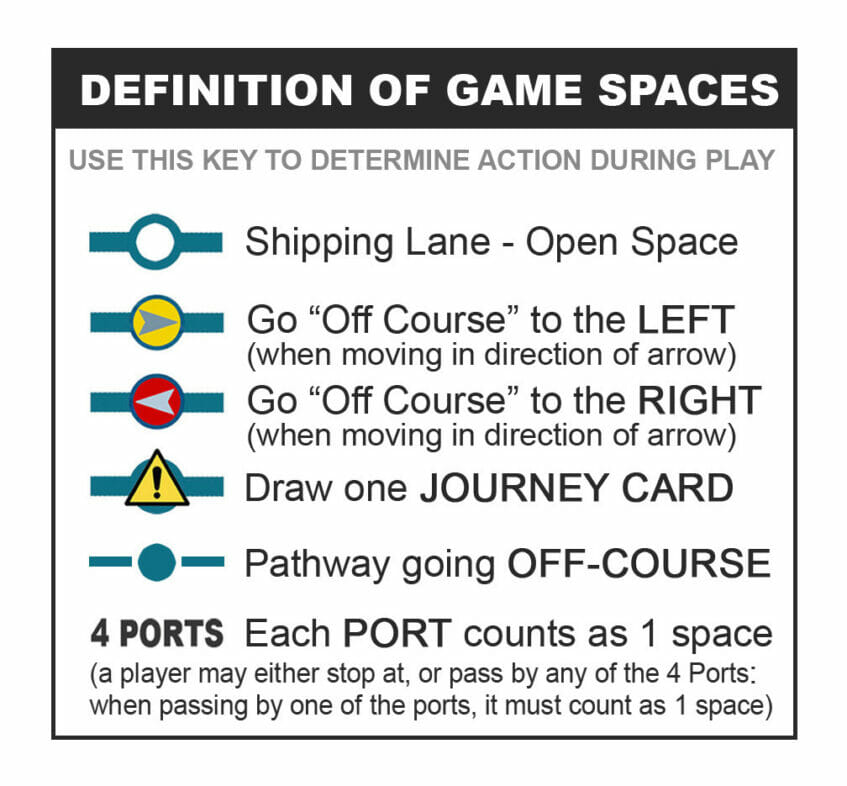

Game Guidelines
Setting The Scene for Game Play : Imagine that for years you have been longing to make some significant changes in your life. Perhaps you have always romanticized about living a life among the paradise islands of the South Pacific? Well, now is the time to throw caution to the wind, buy a used cargo ship and undertake a new life as a Captain in the tropical regions of the South Pacific.
Game Guideline “Quick Select” Categories
OBJECT of South Pacific Adventures "The Island Game"™
In SOUTH PACIFIC ADVENTURES, the object of the game is to complete the required number of TRADE CARD cargo transfers between the 4 port Islands as efficiently as possible, allowing you to proceed to a relaxed and hopefully profitable retirement.
The game ends when TWO players arrive onto RETIREMENT ISLAND (when the tokens of any 2 players are physically on RETIREMENT ISLAND - at the same time). When the game ends, all players may tally up the total amount of money in their possession. The player with the most money is the winner of the game.
As the game progresses, players will find that things do not always go as planned. Players may find that they encounter a host of unique experiences if they become marooned on a deserted island!
GAME SET-UP:
STEP 1 - BOARD LAYOUT: Position the game board in a convenient location, allowing all players to have access.
STEP 2 - POSITION CARD DECKS: Fully shuffle and place each separate game card deck within the specified location onto the game board.
STEP 3 - SET UP THE BANK & FUND EACH PLAYER: Chose a player to act as Banker. The Banker should layout all currency denominations so they can be easily distributed during game play. The Banker should provide $75,000 to each player prior to the game in the following denominations:
- $1,000 bills: FIVE
- $5,000 bills: TWO
- $10,000 bills: TWO
- $20,000 bills: TWO
GAME PLAY:
STEP 1 - CHOSE YOUR STARTING POINT: Each player must select ONE of the 4 Port Islands as their starting point and must place their game token at that location. (Choose from: The Hawaiian Islands, Society Islands, Fiji Islands and New Caledonia). A player may NOT change their starting point once proceeding to STEP 2 below.
STEP 2 - DETERMINE THE LENGTH OF YOUR GAME: Game length is predominantly determined by the number of TRADE CARDS to be played. For example: play 3-4 TRADE CARDS for 4 to 6 players or 5-6 cards to 2 to 3 players.
Once the number of TRADE CARDS has been decided upon, select a player to draw the 1st TRADE CARD. Each additional player (in a clockwise rotation) should proceed to draw one card until all players have drawn the predetermined number of cards.
NOTE: The TRADE CARD deck also includes “MISSION” cards. MISSION cards define a task for the player to carry out rather than specifying a commodity to be transported between ports. Both card types provide clear definition of the task and illustrate the payment to be received upon completion. MISSION cards will list a number of islands to be visited in ANY order determined by the player. In order to complete the “mission” on each island, the player must lose ONE turn on each island where the MISSION card instructs the player to go.
STEP 3 – ORGANIZE YOUR STRATEGY TO WIN: Once players have drawn their TRADE CARDS, each player should take the opportunity to organize the TRADE/MISSION cards they drew. Each commodity TRADE CARD displays the “pick-up at” and “transport to” port locations for that commodity. In order to “pick-up” cargo, the player must already be at the “pick-up at” port or they must proceed to that port for cargo pick-up. (This is the reason that each player must choose their starting port BEFORE selecting TRADE CARDS).
Each player should plan their cargo loads to minimize distances to be traveled on the game board. Whenever possible, a player should organize their cards to align the “transport to” port with the “pick-up at” port of a subsequent card. As an example:

If a player was to draw the 4 TRADE CARDS shown above, the player should align the “pick-up at” and “transport to” ports as shown. This allows the player to pick-up their cargo at the 2 subsequent ports as soon as they deliver the previously transported cargo and collect their payment – minimizing distance traveled on the board. There will be times that there is little or no alignment of ports possible, in that case, the player must travel to each separate port to pick-up and transport the cargo.
CARGO TOKENS: Whenever a player either starts the game at a port where they “pick-up” their cargo OR arrives to a port for cargo “pick-up”, the Banker should assign ONE CARGO TOKEN to that player. The token should be placed onto the TRADE CARD being executed and only be assigned once the player is at the specified “pick up at” port.
Once a player’s cargo has been “picked up”, that player MAY NOT switch cards in order to execute on a different TRADE/MISSION card. Also, it is the responsibility of each player to request the CARGO TOKEN from the Banker. Use of the token assists the player in that they know they have their cargo and must proceed directly to the “transport to” port.
NOTE: A ships manifesto is available to the general public . . . so TRADE CARDS should NOT be kept secret. TRADE/MISSION cards are to be displayed for all players to see.
STEP 4 – BEGIN GAME PLAY: Once all players have had sufficient time to arrange their TRADE/MISSION cards, select a player to begin the game (perhaps have all players roll the die and have the player having the highest number go first?) The player starting the game rolls the die and moves their game token by the number rolled. Each player should take individual turns in a clockwise rotation.
Actions are taken throughout the game based on the spaces landed upon and the directions specified on the various card decks.
DEFINITION OF VARIOUS GAME SPACES & CARDS
GAME SPACES: As players progress through the “shipping lanes” they will come across various marked spaces. Please use this guide to determine the actions taken: It is important for a player to understand that the direction of their travel in the “shipping lane” matters as to whether a game space impacts their travel or not. When a player is moving in the direction of the arrow, and lands on a red or yellow space, they must proceed “OFF-COURSE” on their next turn --- upon their next turn they would roll the die and use the “Pathway going OFF-COURSE” to travel to the adjacent Island.
It is important for a player to understand that the direction of their travel in the “shipping lane” matters as to whether a game space impacts their travel or not. When a player is moving in the direction of the arrow, and lands on a red or yellow space, they must proceed “OFF-COURSE” on their next turn --- upon their next turn they would roll the die and use the “Pathway going OFF-COURSE” to travel to the adjacent Island.
GAME CARDS: Use of Game Card Decks (excluding TRADE CARDS) during game play are to be in the following instances:
- ISLAND CARDS: ISLAND CARDS are drawn once a player has gone “OFF-COURSE” and has become stranded on an island (marked by either a letter A, B, C, D, E, G). The player must draw an ISLAND CARD for each of their turns until they can become “rescued” from the island.
- DANGER ISLAND CARDS: These cards are only drawn if you become stranded on DANGER ISLAND. The player must draw DANGER ISLAND CARDS on each of their turns until they can become “rescued”.
- RETIREMENT ISLAND CARDS: RETIREMENT ISLAND CARDS are ONLY drawn once a player has completed all of their TRADE/MISSION cards and has arrived to their retirement. The “retired” player will draw one card on each of their turns while on RETIREMENT ISLAND and follow the instructions specified.
- JOURNEY CARDS: JOURNEY CARDS are to be drawn by any player who lands on the marked spaces placed within the “shipping lanes”. Follow instructions on the card
“UNIQUE ITEMS” to be HIGHLIGHTED:
- $30,000 BONUS LANE: The “shipping lane” that travels from the Fiji Islands and heading northeast towards the Hawaiian Islands is designated as the “$30,000 Bonus Lane” If a daring ship’s Captain can negotiate this shipping lane WITHOUT landing on an “arrowed go OFF-COURSE” space -- requiring them to go off-course – the Banker awards that player with $30,000. The player must pass through 100% of that shipping lane designated on each end of the shipping lane with a small GREEN dot.
NOTE: An individual player may only collect the $30,000 Bonus TWICE within the course of a single game. - SHIPPING LANE USAGE: Once a player selects a shipping lane to use in order to move towards a destination, they are NOT allowed to reverse direction in that shipping lane on subsequent turns. The player may only reverse direction once they reach one of the 4 shipping ports.
NOTE: The ONLY exception to this rule is if a player draws the JOURNEY CARD informing them that they ”Forgot Your Cargo”. In this case, the player may move in the reverse direction upon their next turn. - ACTION WHEN INSTRUCTED TO MOVE BACKWARD: When a player(s) is instructed to move their token backward (possibly by an ISLAND or JOURNEY card), they are NOT required to be affected by a red or yellow arrowed (go OFF-COURSE) space that they may inadvertently land on after they have moved backward. However, on their following turn, a player would be required to obey any appropriate red or yellow arrowed space when they are moving in their previously determined direction toward their destination.
